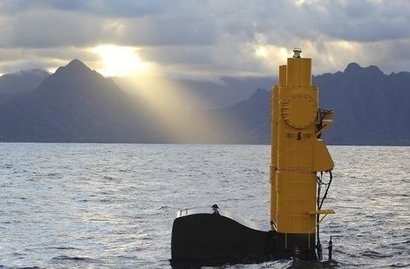
The device will be deployed for 12 months of grid-connected testing as part of a rigorous programme to commercialise the Azura technology. Its development and testing is supported by the US Department of Energy (DOE), the US Navy and the University of Hawaii, which is responsible for data collection, analysis and reporting as an independent means of validating the technology performance.
The data will also be delivered to the US DOE and US Navy for their use in ongoing efforts to validate wave energy technology and advance the marine renewable energy industry. In addition to evaluating system performance in the open ocean over an extended period of time, data collected during the deployment will enable NWEI to develop a more accurate assessment of the technology’s Levelised Cost of Energy (LCOE), which accounts for capital cost, project development cost, life cycle costs and annual energy production. The data will also be used to validate computer simulations to support commercialization of the Azuratechnology.
“As the first grid connected wave energy device in the U.S. that will be tested and validated by an independent party, this deployment marks a major milestone for our team and the marine renewable energy industry” said NWEI Founder and CEO Steve Kopf. “A special thanks to Sea Engineering, our deployment contractor, for their tireless efforts in completing the assembly, launch, and installation of the Azura at WETS.”
Mr Kopf added that standards, rigorous testing, and transparency are the foundations of NWEI’s development programme for the technology and that independent verification of performance data is imperative to achieving commercialisation.
The pilot project builds on NWEI’s deployment of a prototype at the Northwest National Marine Renewable Energy Center’s test site off the coast of Oregon in 2012. This was also supported by the DOE. Experience gained from that testing has been applied to the Azura design, with a focus on optimising the technology’s LCOE through increased power output and improved durability, maintainability and survivability.
The development of the technology was achieved through a collaborative effort between NWEI, Callaghan Innovation and Energy Hydraulics Ltd (EHL). Callaghan Innovation led the conceptualisation and early development of the technology in New Zealand and NWEI has recently secured a global exclusive technology license from them to commercialise it. EHL plays a critical role in advancing the technology and is responsible for the engineering, fabrication and testing of the power conversion system.
Azura is a multi-mode, point absorber wave energy converter developed for the growing international market for utility-scale renewable generation. The device extracts power from both the heave (vertical) and surge (horizontal) motions of waves in order to maximise wave energy capture. The power is generated as a result of the relative rotational motion between the hull and the float while the power takeoff (PTO) system is based on high-pressure hydraulics and is located within the PowerPod.
The float on the device can rotate continuously through 360° or oscillate back and forth. This enables the device to extract energy in a wide variety of wave conditions, improving the overall efficiency of the system. It also provides a self-limiting power shedding effect that makes the device inherently survivable in open ocean environments and helps to reduce loads in the mooring system. Another of Azura’s benefits is that it has a very low reserve buoyancy, which allows it to partially submerge under large waves.
For additional information:

